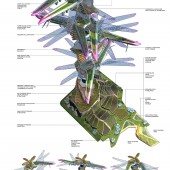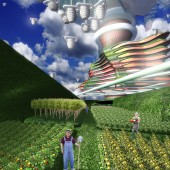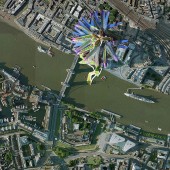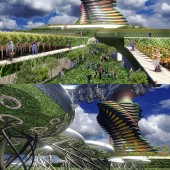
| THE AWARD |
| CATEGORIES |
| REGISTRATION |
| SUBMIT YOUR WORK |
| ENTRY INSTRUCTIONS |
| TERMS & CONDITIONS |
| PUBLICATIONS |
| DATES & FEES |
| METHODOLOGY |
| CONTACT |
| WINNERS |
| PRESS ROOM |
| GET INVOLVED |
| DESIGN PRIZE |
| DESIGN STORE |
| THE AWARD | JURY | CATEGORIES | REGISTRATION | PRESS | WINNERS | PUBLICATIONS | ENTRY INSTRUCTIONS |
Vertical + Horizontal Farm Tower Farming and Crop Distribution Tower by Kevin Chu |
Home > Winners > Design #24667 >Interview |
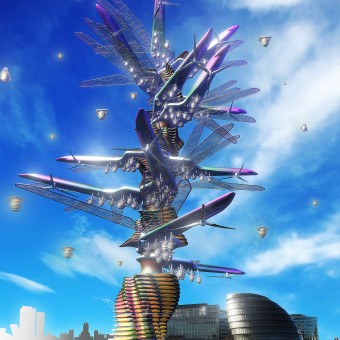 |
|
FS: What is the main principle, idea and inspiration behind your design?
KC: As global population increases and resources are unable to compensate for the insatiable appetite of the human race, the concept of the agricultural metropolis has to be developed to meet this demand. As we all know, more and more people are migrating to cities from the suburbs but the rising cost of logistics, commodity inflation as well as the increase demand for food consumption forces the birth of creating farmlands within the restrictive spaces of a city. This will not only grant city dwellers fresher agricultural products at a lower cost but can also increase green zones and improve surrounding environments. The Vertical Farm was born of these criteria and it was a brilliant solution but I believe there needs to further inspiration in order to make this concept more educational and attractive to the present and future generations. To this day “farming” and the concept of the “farmer” is still viewed by the general public as a low paid and manual intensive labor. More and more youth born from the country side are discontinuing the farming profession in order to seek less physical and higher paid work in cities. I wanted to design a farming community that can truly embrace pioneering technology as well as educate the next generation to view farming as a “cool” profession that can deeply benefit the continuous expansion of the city. The building I started to contemplate does not merely just serve as a vertical farm structure but also an educational and experimental laboratory on agriculture, renewable energy as well as a social environment where farmers and local residents can “mingle” and learn from each other through behavioral science. All the residents in this place gets its own produce for free and the vicinity’s gathered crops can also be distributed around London and sold in a substantially lower market price in minimal amount of time from cultivation. The Vertical+Horizontal farm should manifest a true philosophy of the 21st century farming ideology and create a true social point of this new generation of metropolis agriculture to the world. Inspired the concept of the Sun Dial, Guilin & Yunnan (China) Step Farming method, Aeronautical Engineering as well as the Dragonfly Wing structure, the V+H farm serves as the world’s most technologically advance, fully self-sufficient and eco-friendly structure. All of the green energy technologies within the structure are of experimentation stage at present but I foresee them to replace our current archaic methods. This included Solar Helium Balloons, E.T.F.E Transparent Photovoltaic Skin, Laterally Mounted Wind Turbine as well as Plant Covered External Cladding System that absorbs surrounding CO2 admission of London. The main structure of the building are designed as residential, commercial, research and activity spaces and completely cladded with Perforated Titanium Tiles that allow for plant growth through its holes. Since the structure’s skin will eventually be covered with plants, the whole main building will change in texture and color according to the four seasons and one never has to worry about façade maintenance which leads to a much lower longer term cost and environmental sustainability. The windows of the central structure employs the latest generation of chromatic reflective glass which can control sunlight filtration by means of electrical molecular transformation. The windows also serves as a one-way mirror thus further reducing material need for privacy. Farm fields are located at the ground level as well as each of the horizontal “wing” structure protruding from the building. Each of these “wings” has a 150m structural span and houses farmlands as well as seed research laboratories within its Monocoque structure. The insect like transparent wing canopies are made of E.T.F.E (Ethylene Tetrafluoroethylene) skins with photovoltaic cells embedded within the material. Their function is to turn each of the wing farms into a greenhouse during the colder months of London as well as providing solar energy for the structure and controlling transparency levels within each farm compartment. The complete V+H farm will stand at 312 meters high with one of the tallest organic restaurant, sky lounge, conference hall and theater in the world. Each wing farm is able to rotate 360 degrees from the central axis in order to gain maximum exposure of the sunlight throughout the day while the underneath structure contains storage cocoons gathering crops from farmland above. These cocoons are constructed out of a volumetric telescopic structure and can increase in size according to internal stock volume with their outer skin made of recycled fabrics. The cocoons are actually robots that utilize V.T.O.L (Vertical Take-Off and Landing) propulsion rotary engine which are allocated above the collection structure. Once each cocoon is full they can be guided around London for crop distribution and can be controlled by G.P.S (Global Positioning Satellite) technology same as that found in automobiles. Each cocoon can recharge its electrical energy when it docks back at the main wing farm structure. The design of the protruded wing farm also helps to reduce the building’s footprint on surrounding areas and because each wing is constantly rotating around the main structure, intrusive shadow casting is reduced to a minimum. The ground level of the V+H farm contains further farming fields that function as introduction to the technique and physiology of farming for the casual visitor and beneath these field are residential quarters for V+H resident farmers. The entrance to the main structure is set back between the fields and access walkways are sliced in between forcing the visitor to pass through the farmers’ residence. This is created in order to maximize the interaction between farmers and visitors which through this social manifestation, a better acknowledgment of agriculture will be gained by the layman and hopefully provoke verbal and information promotion. The V+H farm is a dynamic and constantly changing entity in the heart of a buzz ling metropolis. It is an organism that changes, absorb, educate, transform through time and circumstances. I believe it shall become the essence of 21st century agriculture itself and its dynamism will hopefully provoke a new generation to embrace farming in a vastly more innovative and reacceptance attitude.
FS: What has been your main focus in designing this work? Especially what did you want to achieve?
KC: I wanted to create a structure that pave the way to what future metropolis agriculture will be while at the same time introducing the audience to future sustainable technology that are still in its infancy currently. I notice that most present sustainable buildings are not maximizing or exploring new green technology and transformable architectural structure has never been considered seriously. These concepts, i believe, is what architecture has to be headed in order to create truly efficient buildings catering for the continue growth of the food consumption issues face by our planet.
FS: What are your future plans for this award winning design?
KC: Many of the rather "insane" ideas will be trickle down to my current projects and some of the advance sustainable technology such as solar helium balloons canopy will also be investigated in my other designs. I hope this project can be publish in more magazines and architectural articles as i want to create a global forum on discussing future agricultural ideology for our cities.
FS: How long did it take you to design this particular concept?
KC: Around 2months
FS: Why did you design this particular concept? Was this design commissioned or did you decide to pursuit an inspiration?
KC: It was an open competition about vertical farming concepts and i have always been interested in exploring this field.
FS: Is your design being produced or used by another company, or do you plan to sell or lease the production rights or do you intent to produce your work yourself?
KC: I have lectured on this design several times in China and it has been publish in some websites and magazines in China and Italy. I am very open to any interest generated by this design and ideas can be adapted for future projects. I don't think i can sell this design to anyone but if this design sparks any interest for a joint collaboration i will be happy to look into the matter further.
FS: What made you design this particular type of work?
KC: I have always been interested in entomology as well as transformable robotic structure so this projects comes quite naturally to my method of tackling more "conceptual" architecture projects. Also, as with majority of other designers, my company has been moving towards adapting sustainable technology into our projects but i see current design proposals archaic and rather inefficient so in this respect we wanted to push the "green" boundary further!
FS: Where there any other designs and/or designers that helped the influence the design of your work?
KC: I would say more Japanese manga comics and insect structure are my biggest influence.
FS: Who is the target customer for his design?
KC: Just anyone interested in Green architecture and metropolis farming ideology. I suppose sci-fi fans might even like my project!
FS: What sets this design apart from other similar or resembling concepts?
KC: Transformable architecture is rarely ever explored or taken seriously so i think this design is one of the first wave to truly propose it as a viable concept for the city of the future. Also i think it is also one of the first vertical farm structure that can produce crops in large scale to cater for our growing city population.
FS: How did you come up with the name for this design? What does it mean?
KC: Well, since the tower is both vertically and horizontal a farming structure, thus: Vertical + Horizontal Farm tower.
FS: Which design tools did you use when you were working on this project?
KC: I started the sketch a lot in my notebook as always. Then i moved onto Autocad to generate the basic scale and form before rendering in 3D Studio Max and touching up with Photoshop.
FS: What is the most unique aspect of your design?
KC: I think the rotational horizontal wing farms, the flying crops gathering robots, the foliage covered external skin of the building and the solar helium balloons canopy.
FS: Who did you collaborate with for this design? Did you work with people with technical / specialized skills?
KC: I consulted a few friends of mine who are sustainable technology researchers as well as aeronautical engineers.
FS: What is the role of technology in this particular design?
KC: To create a better future for our planet as well as our well being.
FS: What are some of the challenges you faced during the design/realization of your concept?
KC: To come up with a truly original and boundary pushing design that will make people rethink agriculture, architecture and sustainable technology from its current role in our society. This took some time to get my brain light bulb rolling!!!
FS: How did you decide to submit your design to an international design competition?
KC: I was invited into this competition.
FS: What did you learn or how did you improve yourself during the designing of this work?
KC: I learnt a lot more about new sustainable technology as well as gain far more in depth knowledge about farming and the culture of farmers. This has open myself, as well as my studio, to continue exploring these themes in our design and our latest completed project is the fruit of these lessons!
FS: Thank you for providing us with this opportunity to interview you.
A' Design Award and Competitions grants rights to press members and bloggers to use parts of this interview. This interview is provided as it is; DesignPRWire and A' Design Award and Competitions cannot be held responsible for the answers given by participating designers.
| SOCIAL |
| + Add to Likes / Favorites | Send to My Email | Comment | View Press-Release | Translations |
